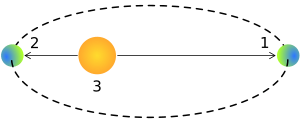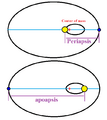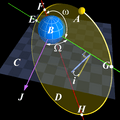Perihelion facts for kids
The perihelion is a special point in space. It's the spot in an object's path around the Sun where it gets closest to the Sun. This object could be a planet, an asteroid, or a comet.
The word "perihelion" comes from ancient Greek. "Peri" means "near," and "Helios" was the Greek god of the Sun. So, it literally means "near the Sun." The opposite of perihelion is aphelion, which is the point where an object is farthest from the Sun.
Contents
Why Orbits Aren't Perfect Circles
All planets, comets, and asteroids in our solar system travel in paths that are not perfect circles. These paths are called elliptical orbits. Think of an ellipse as a slightly squashed circle. Because of this shape, every object has a point where it's closest to the Sun (perihelion) and a point where it's farthest (aphelion).
The "flatness" of an orbit is measured by something called orbital eccentricity. The more "squashed" an ellipse is, the higher its eccentricity. Even though orbits are mostly elliptical, they aren't perfectly fixed. Over long periods, the perihelion point slowly shifts. This slow shift is called precession. It means the orbit isn't a simple, unchanging shape. These tiny changes over thousands of years can affect Earth's climate and are part of what causes Milankovich cycles.
Earth's Perihelion and Aphelion
Our home planet, Earth, also has a perihelion and an aphelion. Every year, Earth gets closest to the Sun around January 3rd. This is its perihelion. It gets farthest from the Sun around July 4th, which is its aphelion.
The difference in distance between these two points is about 3.1 million miles (5 million kilometers). In early January, Earth is about 91.4 million miles (147.1 million kilometers) from the Sun. In early July, it's about 94.5 million miles (152 million kilometers) away.
Perihelion and Seasons
You might think that being closer to the Sun in January would make it warmer. However, when Earth is closest to the Sun in January, it's actually winter in the Northern Hemisphere and summer in the Southern Hemisphere. This shows that Earth's distance from the Sun does not directly cause the seasons.
The main reason for seasons is Earth's axial tilt. Earth does not spin perfectly upright compared to its orbit around the Sun. Instead, its axis is tilted by about 23.5 degrees. This tilt means that as Earth orbits the Sun:
- In December and January, the Sun's rays hit the Southern Hemisphere more directly. This brings summer to the south and winter to the north.
- In June and July, the Sun's rays hit the Northern Hemisphere more directly. This brings summer to the north and winter to the south.
So, winter happens in the part of the world where sunlight hits less directly. Summer happens where sunlight strikes most directly.
Images for kids
-
The two-body system of interacting elliptic orbits: The smaller, satellite body (blue) orbits the primary body (yellow); both are in elliptic orbits around their common center of mass (or barycenter), (red +). ∗Periapsis and apoapsis as distances: The smallest and largest distances between the orbiter and its host body.
See also
 In Spanish: Perihelio para niños
In Spanish: Perihelio para niños




